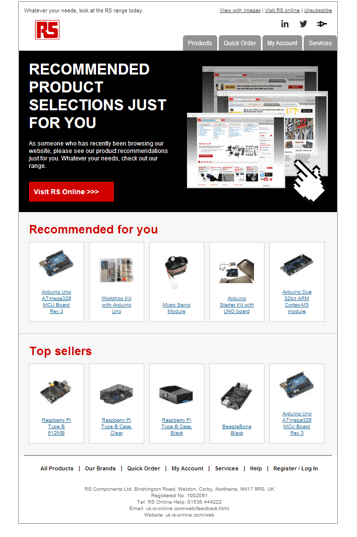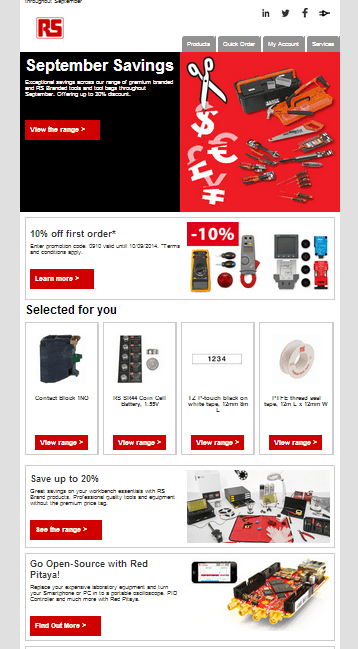A B2B case study showing how to create relevant, personal emails on a global scale.
Email marketing has undergone a transformation lately. The giants of online retail have set a precedent for sending relevant, timely email communications with content tailored to each customer on an individual basis.
Now the rest of us must follow, meeting the high expectations to which online consumers have become accustomed.
No longer is it enough to ‘batch and blast’ a single message to a contact list and hope that some will find it exciting….we must learn what each individual customer finds interesting and send them content to meet their requirements. Email personalisation is undoubtedly here to stay.
Improving personalisation as part of your email strategy however is not straightforward. It requires a significant increase in content production and an even greater amount of data. Even for companies with simple business models and minimal product lines, the deployment of personalised email content can become complex and resource heavy.
How RS Components turned theory into practice to deliver personalised emails
So how does a B2B company with 1.6 million customers and 500,000 products lines from 2,500 suppliers manage to deliver relevant personalised email content across 30 markets in 20 languages consistently, effectively and in a scalable way?
That was the challenge we faced at RS Components when we embarked on a new era of relationship marketing through the email channel. This article will share some of the key challenges we faced from stakeholders and some simple steps which will help to integrate personalisation into your existing email strategy.
Steps to integrate email personalisation
1. Get the basics agreed
Before you can add layers of personalised content to your email programmes, you need to ensure that you have a clear strategy with clearly defined objectives.
Answering the following questions about your email communications strategy will help to define your strategy;
- How many times a week should you email your customers?
- What mix of email messages do you need to accommodate – service, product, both?
- What are KPIs for each email type?
- What data do you have available to use for targeting and automation?
Obviously these answers will differ greatly for each business; a test plan should accompany this strategy to ensure your approach is regularly measured and optimised.
Communicating and agreeing our strategy with all stakeholders at RS was a lengthy but crucial process. With over 300 colleagues in the marketing department, we needed to ensure that our strategy met all their campaign requirements. With their input, we created a monthly framework to suit our communication mix.
This framework enables us to support product promotions, lead nurturing and ‘lifecycle’ emails. Most excitingly however we incorporated new ‘personalised’ emails into our strategy such as ‘Abandoned Baskets’ and ‘Browse not Bought’.

2. The power of process
Unsurprisingly, the process we built to deploy this new mix of RS Components’ emails was crucial to the success of the strategy. This process needed to enable us to gather content, translate it into 30 languages and build the emails on a weekly basis. It also needed to support our personalisation focus.
Again, the starting point for us was to secure stakeholder buy-in to the process. The desire to add personalisation into our marketing plan dramatically increases the amount of content we require from our marketing colleagues.
Therefore we took time to agree a slick process which can now be re-used for every email we build. This means that scheduling each piece of work has become easier and each department is clear on roles, responsibilities and timeframes from the beginning of each email build phase.
Using the tools available to us through our Email Service Provider, Oracle Responsys, we created simple templates which allowed us to take a ‘modular’ approach to email design. This helped us to start with simple targeting rules and we began to build a library of content which can be deployed to each customer in a timely manner.
Each module across all our email programmes is now targeted based on a variety of criteria; Customer’s last order date, their stipulated job role, products they have previously browsed, the country they live in, language preference etc.

But with so many ways to personalise an email, it can be hard to know where to start.
3. Data data data
It goes without saying that the more data you have, the more personalisation you can deploy. That said, starting with a couple of simple pieces of data such as customer order date or the product they purchased, you can begin to deploy relevant, personal messages.
For example, when a customer purchases from you for the first time, this will usually trigger a simple ‘welcome’ programme. By including details of what the customer purchased or even better some related accessories, you are immediately adding a layer of personalisation and proving that your email marketing is highly relevant on an individual basis.
As you begin to learn what pieces of content are most engaging for your customers, you will be able to refine and prioritise the triggers you use and content you send.
At RS, we continue to enjoy success from Abandoned Basket and Browse not Bought emails. These are triggered daily based on a combination of product data, web behavioural data and customers’ order data. Recently through our optimisation plan we have found that by adding product images to the email has doubled our conversion rates.
So what's next in email marketing?
While it’s hard to predict what developments we will see over the coming years, one thing is for sure – customers’ expectations will only continue to increase. Personalisation is the tool which will enable us to meet those expectations, and maybe even exceed them with the right content being delivered to the right contacts at the right time.
Harriet Mitchell explained the RS Components approach to Email marketing at the 2014 Smart Insights conference.
 Thanks to Harriet Mitchell for sharing her advice and opinions in this post. Harriet is the CRM Digital Marketing Manager at Electrocomponents, the world’s leading distributor of electronic, electrical and industrial components. Harriet is responsible for creating the global strategy for all email marketing communications. Communicating to 1.6 million customers across 27 markets, email automation across the customer lifecycle is key in driving relevancy and engagement. Before joining Electrocomponents, Harriet worked as a Marketing Manager at Yours Clothing, where she was responsible for all marketing activities. Harriet brings her previous experience in the retail fashion industry to her current role, putting this knowledge to use in implementing B2C eCommerce best practice in the complex industry of a major B2B global distributor. You can connect with her on LinkedIn.
Thanks to Harriet Mitchell for sharing her advice and opinions in this post. Harriet is the CRM Digital Marketing Manager at Electrocomponents, the world’s leading distributor of electronic, electrical and industrial components. Harriet is responsible for creating the global strategy for all email marketing communications. Communicating to 1.6 million customers across 27 markets, email automation across the customer lifecycle is key in driving relevancy and engagement. Before joining Electrocomponents, Harriet worked as a Marketing Manager at Yours Clothing, where she was responsible for all marketing activities. Harriet brings her previous experience in the retail fashion industry to her current role, putting this knowledge to use in implementing B2C eCommerce best practice in the complex industry of a major B2B global distributor. You can connect with her on LinkedIn.





 Thanks to Harriet Mitchell for sharing her advice and opinions in this post. Harriet is the CRM Digital Marketing Manager at Electrocomponents, the world’s leading distributor of electronic, electrical and industrial components. Harriet is responsible for creating the global strategy for all email marketing communications. Communicating to 1.6 million customers across 27 markets, email automation across the customer lifecycle is key in driving relevancy and engagement. Before joining Electrocomponents, Harriet worked as a Marketing Manager at Yours Clothing, where she was responsible for all marketing activities. Harriet brings her previous experience in the retail fashion industry to her current role, putting this knowledge to use in implementing B2C eCommerce best practice in the complex industry of a major B2B global distributor. You can connect with her on
Thanks to Harriet Mitchell for sharing her advice and opinions in this post. Harriet is the CRM Digital Marketing Manager at Electrocomponents, the world’s leading distributor of electronic, electrical and industrial components. Harriet is responsible for creating the global strategy for all email marketing communications. Communicating to 1.6 million customers across 27 markets, email automation across the customer lifecycle is key in driving relevancy and engagement. Before joining Electrocomponents, Harriet worked as a Marketing Manager at Yours Clothing, where she was responsible for all marketing activities. Harriet brings her previous experience in the retail fashion industry to her current role, putting this knowledge to use in implementing B2C eCommerce best practice in the complex industry of a major B2B global distributor. You can connect with her on 


